 Do your customers use Twitter to ask questions and request support?
Do your customers use Twitter to ask questions and request support?
Need a better way to manage your Twitter support?
By following the steps in this article, you'll deliver a superior customer service experience on Twitter.
In this article, you'll discover how to create a better Twitter customer service process for your business.
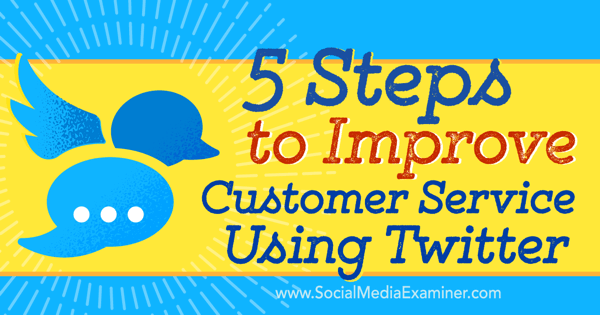
Listen to this article:
Where to subscribe: Apple Podcasts | Spotify | YouTube Music | YouTube | Amazon Music | RSS
#1: Create Internal and External Policies
Create two policies: one to clarify what's expected from internal staff, and the other to address customer expectations and how to ensure their concerns are being heard. Some key considerations and questions to answer include:
What Is the Journey When People Tweet You or Your Brand?
Think about the entire journey from the tweet to response and then action. Without someone constantly monitoring Twitter, it can be very easy to miss tweets sent to your brand.
How Will You Respond and What Will You Say?
Customer service can be tricky. Often tweets are sent from heightened states of emotion. Before reacting, set up an internal policy for team members to outline how to react to any tweets that are time-sensitive, have delicate subject matter, or involve a complaint.
Decide whether to discuss customer concerns within Twitter or move them offline. Twitter's tweaks to its direct messaging platform mean you can choose to allow anyone to direct message you, even when you aren't following each other. This feature is off by default, but you can turn it on within your Security and Privacy settings. This is a great way to allow customers to get in touch in a more private way.

Secondly, Twitter now allows the creation of deep links within tweets. This allows you to embed calls to action such as “Send a private message.” By offering this within a discourse, users can move seamlessly between regular tweets, mentions, and private messaging. Customer service is more ubiquitous.
Lastly, crafting the perfect customer service response can be difficult to do in 140 characters. Many brands and businesses use tools that allow you to link to longer tweets. For customers, however, this disrupts the experience of staying within Twitter to deal with the issue.
One way to get around the 140-character limit is to use a simple Twitter hack that allows you to link a series of replies. Once you write a tweet, click Reply to that tweet, remove your Twitter handle that appears automatically (you don't need it), and type out the second response.
Get World-Class Marketing Training — All Year Long!
Are you facing doubt, uncertainty, or overwhelm? The Social Media Marketing Society can help.
Each month, you’ll receive training from trusted marketing experts, covering everything from AI to organic social marketing. When you join, you’ll also get immediate access to:
- A library of 100+ marketing trainings
- A community of like-minded marketers
- Monthly online community meetups
- Relevant news and trends updates
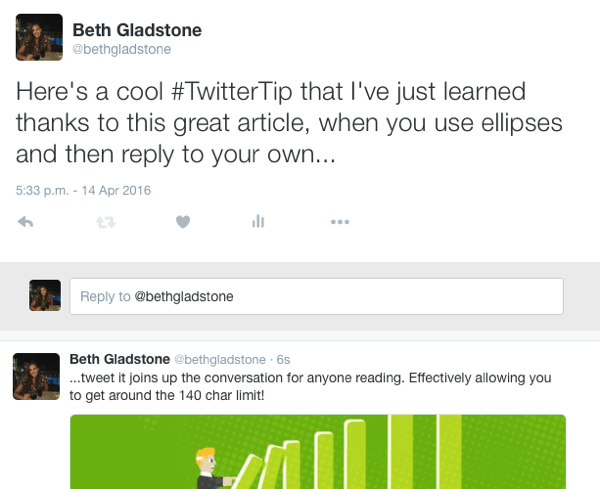
When users click on one of the tweets or choose View Conversation, they'll see the string of replies. Then the conversation is joined up and you haven't had to go into private messaging or another tool to get around the character limit. This is a great Twitter hack for customer service, where you often need more space to take care of your customer.
What Is Your External Policy?
As great as it is to get your team members all on the same page for customer service, it's important to inform your customers so they know what to expect. If your Twitter handle is answered around the clock, great!
However, you can also set hours of business where your team can respond quickly to queries on Twitter, and then add this information to your Twitter bio or as a pinned tweet. That way, customers know where to turn at any hour of the day and are given an option for any high-priority communication.
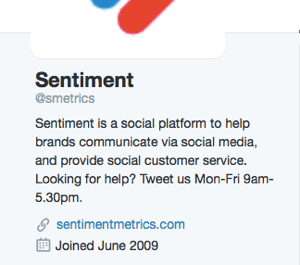
#2: Assign Role Responsibility
Whose job is it to manage your customer service online? If the responsibility lies with just one person, it's fairly easy. However, if there are multiple customer service advocates for your brand, or the number changes on weekends and holidays, then you need a structure for areas of responsibility.
You can use a calendar or Google sheet to assign responsibility and show who's in charge and when. You can enhance it by using color-coding or a tagging system. If you use a customer service tool, it's even easier. You can assign tweets and days when specific team members are in charge of your account.
For some brands, this also means you can add an element of personality to tweets and responses, so your customers know who's behind the updates. You might include a name or initials or even mention in your bio the names of the customer service champs your customers will be exposed to.
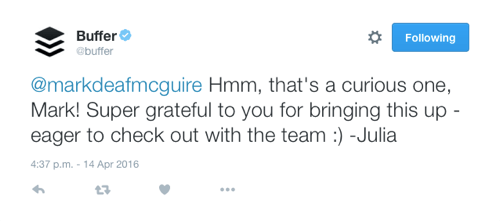
#3: Create a Flowchart for Inbound Attention
A PR crisis is the last thing you want on Twitter. At the same time, though, you shouldn't be afraid to converse and interact with your customers and followers. Many Twitter users with large followings cite conversing and interacting with their followers as a way to grow and gain attention.

Discover Proven Marketing Strategies and Tips
Want to go even deeper with your marketing? Check out the Social Media Marketing Podcast! Publishing weekly since 2012, the Social Media Marketing Podcast helps you navigate the constantly changing marketing jungle, with expert interviews from marketing pros.
But don’t let the name fool you. This show is about a lot more than just social media marketing. With over 600 episodes and millions of downloads each year, this show has been a trusted source for marketers for well over a decade.
Inbound attention can be great for exposure and opportunity, but only when handled right. This means you need to set the tone for how you want your inbound attention to be handled and ensure that everyone is on the same page.
For example, do you retweet every person who shares an article, quote, or image you created? Do you thank them personally? Or do you show appreciation with a simple like? Establish simple rules for managing and responding to inbound attention and then ensure all team members with access to your social media account are aware of how it should work.
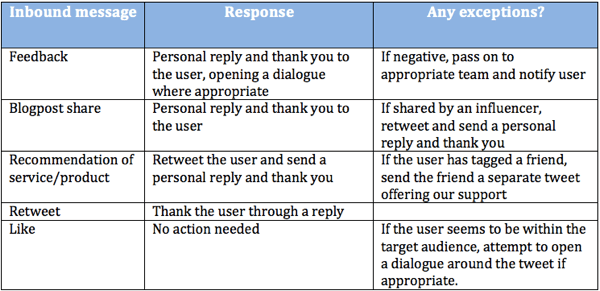
You can create a straightforward template to display in your office or as a Google doc.
#4: Set Up Response Templates
Just like email customer service, your Twitter responses may be repetitive. To save minutes (and possibly hours) over time, collect the most commonly needed information, answers, or associated feedback to quickly batch your customer service responses.
You can create this template within a Google spreadsheet or similar tool. This gives your team fast access to responses that can be copied and pasted into Twitter or your social media monitoring tool.
One tip to make your Google sheet more Twitter-friendly is to use the character count formula. Next to the column that contains your pre-created tweets, enter the formula =len(B2) (change the ‘B2' to the cell number your tweet response is in). Once entered, this will calculate how many characters are within that cell, helping you ensure there are fewer than 140.
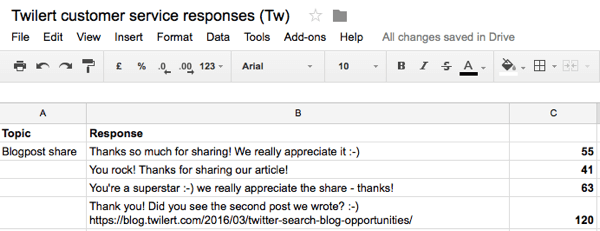
Also remember that you'll need to enter the handle of the user you're replying to. The maximum character count for a Twitter handle is 15, so if you allow for 15 characters plus one space for the handle, this leaves 124 characters out of the original 140 to craft your message. Luckily, most user handles contain fewer than 15 characters, so this will leave space for your users to add an RT or even MT (modified tweet) if they wish to share your reply.
#5: Reach Out to Customers and Prospects Alike
Part of great customer service is making your customers feel great! Use Twitter to publicly support your customers and make them feel special.
Make a Twitter list of customers who are on Twitter. If you need help finding their handles, you can use a tool such as Clearbit to help track them down. Next, scan through the list to find questions, articles, or conversations that you can join with your audience. Where you can, share your customers' articles or services to show you're as loyal to them as they are to you.
To find additional customers similar to your customers, choose the Whom to Follow tool in Twitter, which generates a list of customers similar to yours. Once selected, advocate for them, too. You can also use Twitter search to target customers within your niche by keywords in their bio. For example, if your audience has many fans of rock music, search in the Twitter toolbar for “rock music” and then select More Options and Accounts.
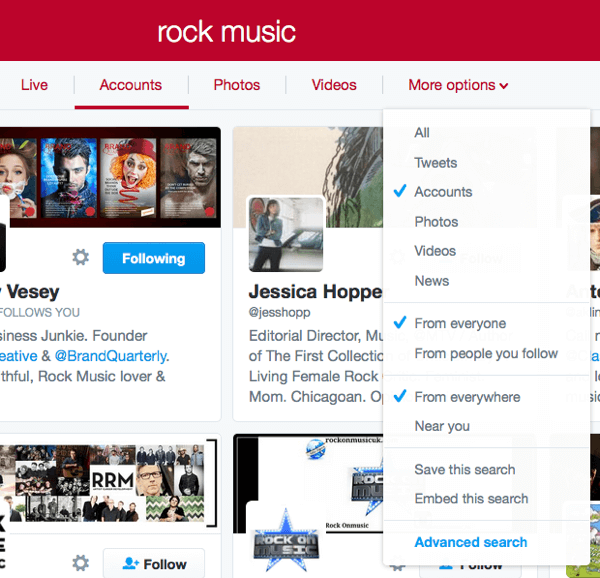
You can use Twitter Advanced Search to find customers who may be indirectly talking about your brand or uncover an area that you can contribute to. Think about the keywords people may use when talking about an area of interest that you could use to build rapport. You could even use the Twitter search operator “OR” to build a bigger pool of tweets.
For example, “social media monitoring” OR “love social media” OR “social media question” would curate a feed of brand advocates who are passionate about social media and whom you could potentially engage with. Just remember the three golden Cs: customer service, connection (personalized), and collaboration. These will ensure that you're giving something back to your customer and not just selling.
The tweet trail below is a great example of how one company used Twitter search to surprise and delight their audience. By creating a Twitter search that looked for the word “German,” or perhaps “consult” and “German,” the German embassy in London came up with an entertaining, timely, and personalized reply to help connect with the user.

Conclusion
Providing great customer service on Twitter (or any other social media channel) isn't always easy, but it remains essential for your brand arsenal when it comes to keeping your customers and clients happy. Being successful means creating a clear internal and external policy for your company, providing clear guidance to customers, and using the channel as a way to monitor and respond to inbound attention. All within 140 characters, of course!
With the right strategy in place, your Twitter feed can become a powerful means of gaining new customers and impressing existing ones.
What do you think? Do you find customer service on Twitter tricky? What strategies does your business use? Share your thoughts in the comments below!
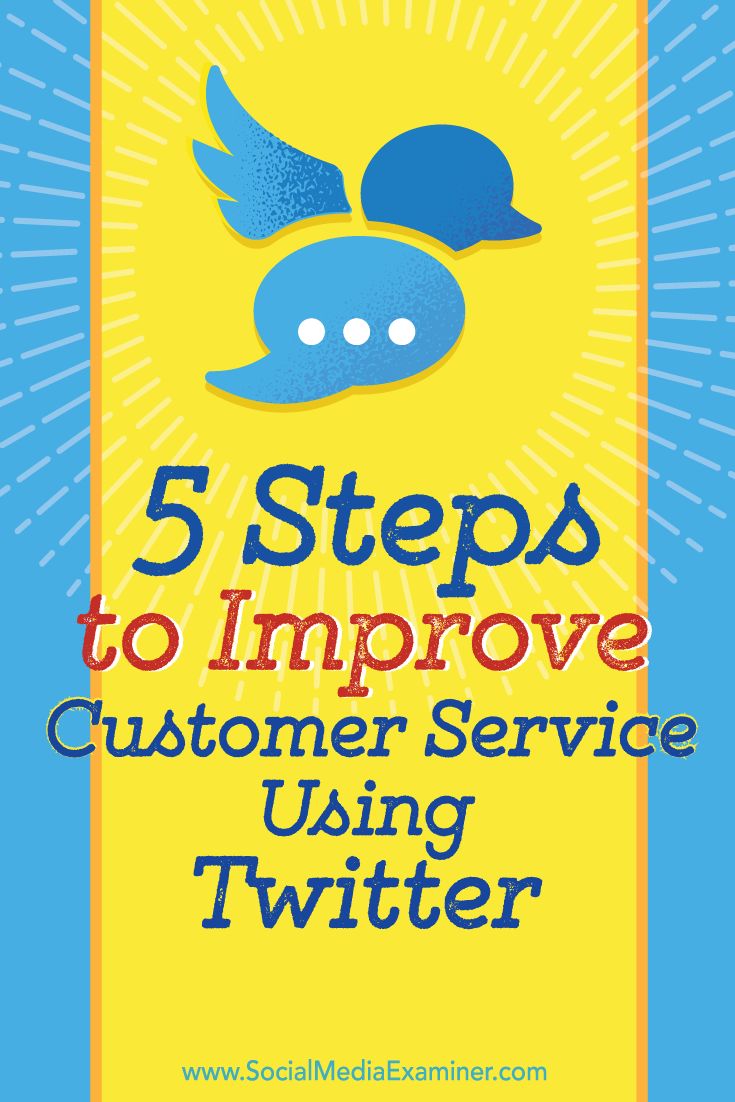
Attention Agency Owners, Brand Marketers, and Consultants

Introducing the Marketing Agency Show–our newest podcast designed to explore the struggles of agency marketers.
Join show host and agency owner, Brooke Sellas, as she interviews agency marketers and digs deep into their biggest challenges. Explore topics like navigating rough economic times, leveraging AI, service diversification, client acquisition, and much more.
Just pull up your favorite podcast app, search for Marketing Agency Show and start listening. Or click the button below for more information.

